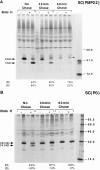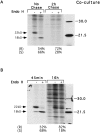Neurons promote the translocation of peripheral myelin protein 22 into myelin
- PMID: 9315897
- PMCID: PMC6793898
- DOI: 10.1523/JNEUROSCI.17-20-07754.1997
Neurons promote the translocation of peripheral myelin protein 22 into myelin
Abstract
Schwann cells express low levels of myelin proteins in the absence of neurons. When Schwann cells and neurons are cultured together the production of myelin proteins is elevated, and myelin is formed. For peripheral myelin protein 22 (PMP22), the exact amount of protein produced is critical, because peripheral neuropathies result from its underexpression or overexpression. In this study we examined the effect of neurons on Schwann cell PMP22 production in culture and in peripheral nerve using metabolic labeling and pulse-chase studies as well as immunocytochemistry. Most of the newly synthesized PMP22 in Schwann cells is rapidly degraded in the endoplasmic reticulum. Only a small proportion of the total PMP22 acquires complex glycosylation and accumulates in the Golgi compartment. This material is translocated to the Schwann cell membrane in detectable amounts only when axonal contact and myelination occur. Myelination does not, however, alter the rapid turnover of PMP22 in Schwann cells. PMP22 may therefore be a unique myelin protein in that axonal contact promotes its insertion into the Schwann cell membrane and myelin without altering its rapid turnover rate within the cell.
Figures







Similar articles
-
PMP22 carrying the trembler or trembler-J mutation is intracellularly retained in myelinating Schwann cells.Neurobiol Dis. 2000 Dec;7(6 Pt B):561-73. doi: 10.1006/nbdi.2000.0323. Neurobiol Dis. 2000. PMID: 11114256
-
Detection and processing of peripheral myelin protein PMP22 in cultured Schwann cells.J Biol Chem. 1993 May 15;268(14):10372-9. J Biol Chem. 1993. PMID: 8486695
-
Coexpression of PMP22 gene with MBP and P0 during de novo myelination and nerve repair.Glia. 1993 Aug;8(4):256-64. doi: 10.1002/glia.440080406. Glia. 1993. PMID: 7691737
-
Regulation of myelin-specific gene expression. Relevance to CMT1.Ann N Y Acad Sci. 1999 Sep 14;883:91-108. Ann N Y Acad Sci. 1999. PMID: 10586235 Review.
-
Actions of progesterone and its 5alpha-reduced metabolites on the major proteins of the myelin of the peripheral nervous system.Steroids. 2003 Nov;68(10-13):825-9. doi: 10.1016/s0039-128x(03)00134-x. Steroids. 2003. PMID: 14667974 Review.
Cited by
-
In Vivo Ultrafast Doppler Imaging Combined with Confocal Microscopy and Behavioral Approaches to Gain Insight into the Central Expression of Peripheral Neuropathy in Trembler-J Mice.Biology (Basel). 2023 Oct 10;12(10):1324. doi: 10.3390/biology12101324. Biology (Basel). 2023. PMID: 37887034 Free PMC article.
-
HSP90 Inhibitor, NVP-AUY922, Improves Myelination in Vitro and Supports the Maintenance of Myelinated Axons in Neuropathic Mice.ACS Chem Neurosci. 2019 Jun 19;10(6):2890-2902. doi: 10.1021/acschemneuro.9b00105. Epub 2019 May 3. ACS Chem Neurosci. 2019. PMID: 31017387 Free PMC article.
-
Biochemical characterization of protein quality control mechanisms during disease progression in the C22 mouse model of CMT1A.ASN Neuro. 2013 Dec 3;5(5):e00128. doi: 10.1042/AN20130024. ASN Neuro. 2013. PMID: 24175617 Free PMC article.
-
Peripheral myelin protein 22 is in complex with alpha6beta4 integrin, and its absence alters the Schwann cell basal lamina.J Neurosci. 2006 Jan 25;26(4):1179-89. doi: 10.1523/JNEUROSCI.2618-05.2006. J Neurosci. 2006. PMID: 16436605 Free PMC article.
-
The homology model of PMP22 suggests mutations resulting in peripheral neuropathy disrupt transmembrane helix packing.Biochemistry. 2014 Oct 7;53(39):6139-41. doi: 10.1021/bi500809t. Epub 2014 Sep 25. Biochemistry. 2014. PMID: 25243937 Free PMC article.
References
-
- Adlkofer K, Martini R, Aguzzi A, Zielasek J, Toyka KV, Suter U. Hypermyelination and demyelinating peripheral neuropathy in Pmp22-deficient mice. Nat Genet. 1995;11:274–280. - PubMed
-
- Bosse F, Zoidl G, Wilms S, Gillen CP, Kuhn HG, Müller HW. Differential expression of two mRNA species indicates a dual function of peripheral myelin protein PMP22 in cell growth and myelination. J Neurosci Res. 1994;37:529–537. - PubMed
-
- Brockes JP, Fields KL, Raff MC. Studies on cultured rat Schwann cells. I. Establishment of purified populations from cultures of peripheral nerve. Brain Res. 1979;165:105–118. - PubMed
-
- Brunden KR. Age-dependent changes in the oligosaccharide structure of the major myelin glycoprotein, P0. J Neurochem. 1992;58:1659–1666. - PubMed
Publication types
MeSH terms
Substances
Grants and funding
LinkOut - more resources
Full Text Sources
